INSTITUT SUPERIEUR D'ANTHROPOLOGIE
INSTITUTE OF ANTHROPOLOGY
ONLINE COURSES / COURS A DISTANCE
INSCRIPTION : Année Universitaire 2012/2013
REGISTRATION : Academic Year 2012 / 2013
ARMENIE – 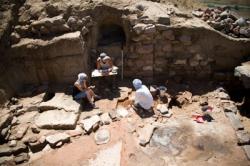 Masis Hill - The excavation of 37 different monuments has been undertaken by the National Institute of Archeology and Ethnology of the National Academy of Sciences of the Republic of Armenia and the results are satisfying. As the director of the Institute Pavel Avetisyan mentioned in the conversation with "Armenpress" not only excavations, but testing and research have been executed in those ancient places. Excavations in 10 archeological units are still being carried out. He said: "This year we have carried out excavation in Masis hill nearby Yerevan, which is a monument dating back to the Stone Age and probably the most part of the hill was devastated during 1970s, but the layers are still safe. The Armenian-American expedition has already discovered the constructions with round plan and dug out a large amount of instruments from bones and stones." According to Pavel Avetisyan among other things one unique finding has been discovered and depictions on its surface tell us about the fact that probably it belongs to the first half of the 6th millennium B. C. Notwithstanding, this should be proved by an exploration. As the Director of the National Institute of Archeology and Ethnology of the National Academy of Sciences of the Republic of Armenia archeological works in Areni Cave are still in process, although currently the expedition is more focused on the procedure of settlement of the group. Archeological excavations have been initiated in a number of Armenian capitals of various periods like Yervandashat, Artashat, Armavir and Dvin.
Masis Hill - The excavation of 37 different monuments has been undertaken by the National Institute of Archeology and Ethnology of the National Academy of Sciences of the Republic of Armenia and the results are satisfying. As the director of the Institute Pavel Avetisyan mentioned in the conversation with "Armenpress" not only excavations, but testing and research have been executed in those ancient places. Excavations in 10 archeological units are still being carried out. He said: "This year we have carried out excavation in Masis hill nearby Yerevan, which is a monument dating back to the Stone Age and probably the most part of the hill was devastated during 1970s, but the layers are still safe. The Armenian-American expedition has already discovered the constructions with round plan and dug out a large amount of instruments from bones and stones." According to Pavel Avetisyan among other things one unique finding has been discovered and depictions on its surface tell us about the fact that probably it belongs to the first half of the 6th millennium B. C. Notwithstanding, this should be proved by an exploration. As the Director of the National Institute of Archeology and Ethnology of the National Academy of Sciences of the Republic of Armenia archeological works in Areni Cave are still in process, although currently the expedition is more focused on the procedure of settlement of the group. Archeological excavations have been initiated in a number of Armenian capitals of various periods like Yervandashat, Artashat, Armavir and Dvin.
http://armenpress.am/eng/news/697250/rare-findings-dating-back-to-the-6th-millennium-b-c-have-been-dug-out-in-masis-hill.html
ROYAUME UNI – 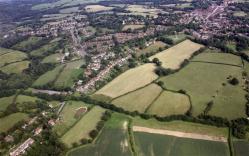 Battle - Historian believes the 10,000 victims of the Battle of Hastings are actually buried in a field one mile north west of the official site at Battle. The site of where the Battle of Hastings has been commemorated for the last 1,000 years is in the wrong place, it has been claimed. Ever since the 1066 battle that led to the Norman Conquest, history has recorded the event as happening at what is now Battle Abbey in the East Sussex town. But although some 10,000 men are believed to have been killed in the historic conflict, no human remains or artefects from the battle have ever been found at the location. This has given rise to several historians to examine alternative sites for the battle that was a decisive victory for William the Conqueror and saw the death of King Harold. Now historian and author John Grehan believes he has finally found the actual location - on a steep hill one mile north west of Battle. It is documented that Harold assembled his English army on Caldbec Hill before advancing on Senlac Hill (Battle Hill) a mile away to meet the invading Normans. But Mr Grehan believes his research shows Harold never left his defensive hilltop position and the Normans took the battle to the English.
Battle - Historian believes the 10,000 victims of the Battle of Hastings are actually buried in a field one mile north west of the official site at Battle. The site of where the Battle of Hastings has been commemorated for the last 1,000 years is in the wrong place, it has been claimed. Ever since the 1066 battle that led to the Norman Conquest, history has recorded the event as happening at what is now Battle Abbey in the East Sussex town. But although some 10,000 men are believed to have been killed in the historic conflict, no human remains or artefects from the battle have ever been found at the location. This has given rise to several historians to examine alternative sites for the battle that was a decisive victory for William the Conqueror and saw the death of King Harold. Now historian and author John Grehan believes he has finally found the actual location - on a steep hill one mile north west of Battle. It is documented that Harold assembled his English army on Caldbec Hill before advancing on Senlac Hill (Battle Hill) a mile away to meet the invading Normans. But Mr Grehan believes his research shows Harold never left his defensive hilltop position and the Normans took the battle to the English.
http://www.telegraph.co.uk/earth/environment/archaeology/9632922/Are-bodies-of-10000-lost-warriors-from-Battle-of-Hastings-buried-in-this-field.html
INDONESIE – 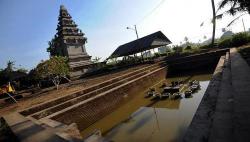 Bali - Construction workers in Bali have discovered what is thought to be the biggest ancient Hindu temple ever found on the Indonesian island, archaeologists said. The workers were digging a drain in the island's capital Denpasar at a Hindu study centre when they came across the remains of the stone temple. They reported the discovery to the Bali archaeology office, which then unearthed substantial foundations of a structure that the excavation team believes dates from around the 13th to 15th centuries. "We think this is the biggest ancient Hindu temple ever discovered in Bali," Wayan Suantika, the head of the team, said late Wednesday. The Wasan temple in the village of Sukawati in Bali , was currently the biggest ancient Hindu temple ever unearthed on Bali, reconstructed after its discovery in 1986.
Bali - Construction workers in Bali have discovered what is thought to be the biggest ancient Hindu temple ever found on the Indonesian island, archaeologists said. The workers were digging a drain in the island's capital Denpasar at a Hindu study centre when they came across the remains of the stone temple. They reported the discovery to the Bali archaeology office, which then unearthed substantial foundations of a structure that the excavation team believes dates from around the 13th to 15th centuries. "We think this is the biggest ancient Hindu temple ever discovered in Bali," Wayan Suantika, the head of the team, said late Wednesday. The Wasan temple in the village of Sukawati in Bali , was currently the biggest ancient Hindu temple ever unearthed on Bali, reconstructed after its discovery in 1986.
http://www.straitstimes.com/breaking-news/se-asia/story/balis-largest-ancient-hindu-temple-discovered-20121025
FRANCE – 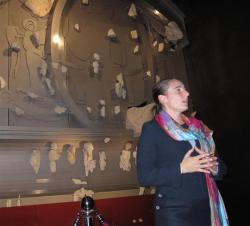 Cluny - Hier au musée d’art et d’archéologie de Cluny, a eu lieu l’inauguration officielle de la reconstitution monumentale du Grand Portail de l’église abbatiale Cluny III, détruit à l’explosif en 1810. S’appuyant notamment sur les travaux de l’archéologue américain K.J. Conant cette reconstitution, véritable enquête ou puzzle archéologique, est le fruit d’un travail de titan regroupant de nombreuses compétences, soit, bénévoles comme celles des membres du Centre d’études clunisiennes, sous l’égide de Jean-Denis Salvèque, soit professionnelles. Un film 3D a été conçu par le laboratoire d’imagerie numérique de l’ENSAM de Cluny et la société chalonnaise on situ. Un film permettant de s’immerger complètement dans l’atmosphère de ce bâtiment gigantesque dont le portail (20 m de haut sur 14 m de large) se trouva être l’un des plus importants de l’occident roman.
Cluny - Hier au musée d’art et d’archéologie de Cluny, a eu lieu l’inauguration officielle de la reconstitution monumentale du Grand Portail de l’église abbatiale Cluny III, détruit à l’explosif en 1810. S’appuyant notamment sur les travaux de l’archéologue américain K.J. Conant cette reconstitution, véritable enquête ou puzzle archéologique, est le fruit d’un travail de titan regroupant de nombreuses compétences, soit, bénévoles comme celles des membres du Centre d’études clunisiennes, sous l’égide de Jean-Denis Salvèque, soit professionnelles. Un film 3D a été conçu par le laboratoire d’imagerie numérique de l’ENSAM de Cluny et la société chalonnaise on situ. Un film permettant de s’immerger complètement dans l’atmosphère de ce bâtiment gigantesque dont le portail (20 m de haut sur 14 m de large) se trouva être l’un des plus importants de l’occident roman.
http://www.lejsl.com/saone-et-loire/2012/10/14/inauguration-du-grand-portail-de-cluny-iii
FRANCE – 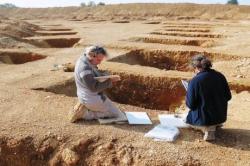 St Sauveur des Landes – Une importante ferme gauloise a été mise au jour à Saint-Sauveur-des-Landes dans le cadre de recherches archéologiques préventives au sud de la zone d’aménagement concerté (Zac) de Plaisance. Depuis la mi-juillet, les fouilles sont menées par l’Inrap. Le diagnostic réalisé en 2010 avait mis en évidence la présence de plusieurs structures archéologiques. Elles témoignent d’une occupation du site à l’époque gauloise, sur une surface de plus de deux hectares. La conservation exceptionnelle des structures et du mobilier offre aux archéologues plusieurs opportunités de recherches. La phase d’études qui suivra la fouille permettra d’enrichir les connaissances sur les pratiques quotidiennes des Gaulois. Et notamment d’obtenir une image précise du mode de vie et de l’évolution de cette ferme au cours des deux ou trois siècles de son existence.
St Sauveur des Landes – Une importante ferme gauloise a été mise au jour à Saint-Sauveur-des-Landes dans le cadre de recherches archéologiques préventives au sud de la zone d’aménagement concerté (Zac) de Plaisance. Depuis la mi-juillet, les fouilles sont menées par l’Inrap. Le diagnostic réalisé en 2010 avait mis en évidence la présence de plusieurs structures archéologiques. Elles témoignent d’une occupation du site à l’époque gauloise, sur une surface de plus de deux hectares. La conservation exceptionnelle des structures et du mobilier offre aux archéologues plusieurs opportunités de recherches. La phase d’études qui suivra la fouille permettra d’enrichir les connaissances sur les pratiques quotidiennes des Gaulois. Et notamment d’obtenir une image précise du mode de vie et de l’évolution de cette ferme au cours des deux ou trois siècles de son existence.
http://www.ouest-france.fr/actu/actuLocale_-Saint-Sauveur-des-Landes-35-.-Une-importante-ferme-gauloise-mise-au-jour_40771-2126524-pere-region--35360-abd_filDMA.Htm